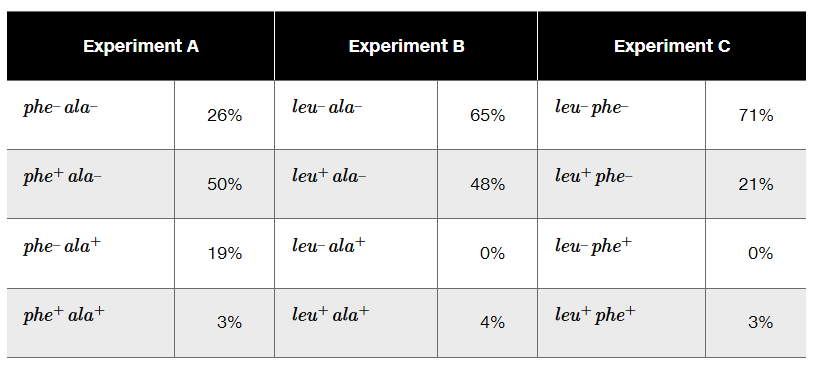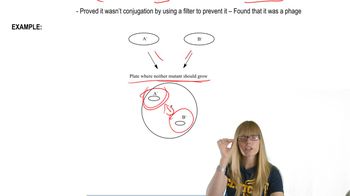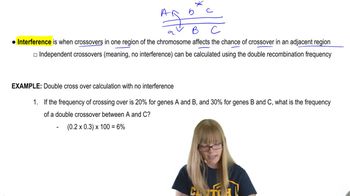How is the frequency of cotransduction related to the relative positions of genes on a bacterial chromosome? Draw a map of three genes and describe the expected relationship of cotransduction frequencies to the map.
Table of contents
- 1. Introduction to Genetics51m
- 2. Mendel's Laws of Inheritance3h 37m
- 3. Extensions to Mendelian Inheritance2h 41m
- 4. Genetic Mapping and Linkage2h 28m
- 5. Genetics of Bacteria and Viruses1h 21m
- 6. Chromosomal Variation1h 48m
- 7. DNA and Chromosome Structure56m
- 8. DNA Replication1h 10m
- 9. Mitosis and Meiosis1h 34m
- 10. Transcription1h 0m
- 11. Translation58m
- 12. Gene Regulation in Prokaryotes1h 19m
- 13. Gene Regulation in Eukaryotes44m
- 14. Genetic Control of Development44m
- 15. Genomes and Genomics1h 50m
- 16. Transposable Elements47m
- 17. Mutation, Repair, and Recombination1h 6m
- 18. Molecular Genetic Tools19m
- 19. Cancer Genetics29m
- 20. Quantitative Genetics1h 26m
- 21. Population Genetics50m
- 22. Evolutionary Genetics29m
5. Genetics of Bacteria and Viruses
Transduction
Problem 24c
Textbook Question
The phage P1 is used as a generalized transducing phage in an experiment combining a donor strain of E. coli of genotype leu⁺ phe⁺ ala⁺ and a recipient strain that is leu⁻ phe⁻ ala⁻. In separate experiments, transductants are selected for leu⁺ (Experiment A), for ala⁺ (Experiment B), and for phe⁺ (Experiment C). Following selection, transductant genotypes for the unselected markers are identified. The selection experiment results below show the frequency of each genotype.

Diagram the crossover events that form each of the transductants in Experiment A.
 Verified step by step guidance
Verified step by step guidance1
Step 1: Understand the experimental setup. The phage P1 is used for generalized transduction, which involves transferring genetic material from a donor strain (leu⁺ phe⁺ ala⁺) to a recipient strain (leu⁻ phe⁻ ala⁻). The goal is to analyze the genotypes of transductants selected for leu⁺ in Experiment A and determine the crossover events responsible for their formation.
Step 2: Analyze the genotype frequencies in Experiment A. The transductants selected for leu⁺ are categorized into four groups based on the unselected markers (phe and ala): phe⁻ ala⁻ (26%), phe⁺ ala⁻ (50%), phe⁻ ala⁺ (19%), and phe⁺ ala⁺ (3%). These frequencies provide clues about the proximity of the genes and the likelihood of crossover events.
Step 3: Diagram the genetic arrangement of the donor strain. Assume the genes leu, phe, and ala are linked on the bacterial chromosome. Represent the donor strain as a linear sequence: leu⁺ - phe⁺ - ala⁺. The recipient strain has the corresponding alleles: leu⁻ - phe⁻ - ala⁻. The phage P1 transfers segments of the donor DNA to the recipient, and recombination occurs.
Step 4: Identify crossover events for each transductant genotype. For example: (a) phe⁻ ala⁻ transductants (26%) likely result from no crossover, where only the leu⁺ gene is transferred. (b) phe⁺ ala⁻ transductants (50%) suggest a single crossover event between leu and phe, transferring both leu⁺ and phe⁺. (c) phe⁻ ala⁺ transductants (19%) indicate a single crossover event between phe and ala, transferring leu⁺ and ala⁺. (d) phe⁺ ala⁺ transductants (3%) result from a double crossover event, transferring all three genes (leu⁺, phe⁺, ala⁺).
Step 5: Summarize the crossover events in a diagram. Create a visual representation showing the donor and recipient DNA, the location of the genes, and the crossover points for each transductant genotype. This will help illustrate how the different genotypes are formed during transduction.
 Verified video answer for a similar problem:
Verified video answer for a similar problem:This video solution was recommended by our tutors as helpful for the problem above
Video duration:
5mPlay a video:
Was this helpful?
Key Concepts
Here are the essential concepts you must grasp in order to answer the question correctly.
Generalized Transduction
Generalized transduction is a process by which bacteriophages (viruses that infect bacteria) transfer genetic material from one bacterium to another. During this process, a phage can accidentally package bacterial DNA instead of its own and introduce it into a new host cell upon infection. This mechanism allows for the exchange of genetic traits, such as antibiotic resistance or metabolic capabilities, between different bacterial strains.
Recommended video:
Guided course

Transduction
Crossover Events
Crossover events refer to the exchange of genetic material between homologous chromosomes during meiosis or genetic recombination. In the context of transduction, these events can occur when the phage integrates bacterial DNA into the recipient's genome, leading to new combinations of alleles. Understanding these events is crucial for analyzing the resulting genotypes of transductants, as they determine which traits are inherited by the offspring.
Recommended video:
Guided course

Multiple Cross Overs and Interference
Selection of Transductants
Selection of transductants involves identifying and isolating bacterial cells that have successfully acquired new genetic traits through transduction. In the experiments described, specific markers (leu⁺, phe⁺, ala⁺) are selected to determine the efficiency of gene transfer. The frequency of different genotypes among the transductants provides insights into the effectiveness of the transduction process and the linkage between genes, which can be visualized through crossover diagrams.
Recommended video:
Guided course

Transduction
Related Videos
Related Practice
Textbook Question
880
views


